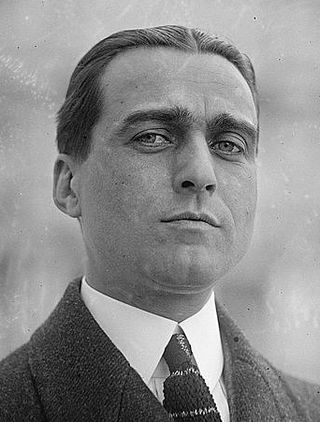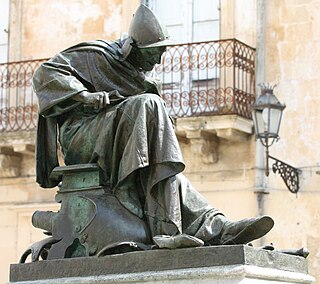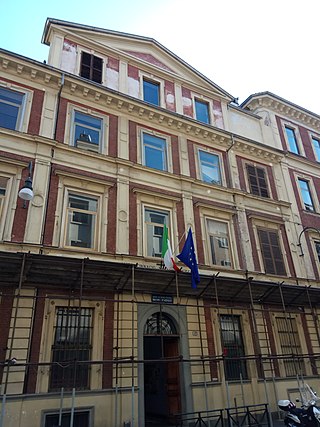
The Marquis D'Azeglio as caricatured by Ape (Carlo Pellegrini) in Vanity Fair, June 1874
Vittorio Emanuele Taparelli d'Azeglio (17 September 1816 - 24 April 1890) was an Italian diplomat and politician born in Turin.

Vittorio Emanuele Taparelli d'Azeglio (17 September 1816 - 24 April 1890) was an Italian diplomat and politician born in Turin.
Taparelli was descended from Piedmontese nobility, the marchesi d'Azeglio (margraves of Azeglio). His father was Roberto d'Azeglio, older brother of statesman Massimo d'Azeglio. He served as a Sardinian diplomat and eventually as minister, including postings to Bavaria, Vienna, The Hague, St Petersburg, London and Paris.
He was a co-founder of the St James's Club in London in 1857. He was an art collector, and was for a time President of the Burlington Fine Arts Club in London.
On his retirement from the diplomatic service in 1871 he was appointed a senator in the 11th Legislature of the Kingdom of Italy.

Cesare Balbo, Conte di Vinadio, was an Italian writer and statesman.

James Rennell Rodd, 1st Baron Rennell,, known as Sir Rennell Rodd before 1933, was a British diplomat, poet and politician. He served as British Ambassador to Italy during the First World War.

Massimo Taparelli, Marquess of Azeglio, commonly called Massimo d'Azeglio, was a Piedmontese-Italian statesman, novelist, and painter. He was Prime Minister of Sardinia for almost three years until succeeded by his rival Camillo Benso, Count of Cavour. A moderate liberal and member of the Moderate Party associated with the Historical Right, d'Azeglio hoped for a federal union between Italian states.

Carlo Passaglia was an Italian Jesuit and theologian.

The St James's Hotel and Club is a hotel at 7-8, Park Place, St. James's, London SW1A 1LP and is part of Pakistani multinational conglomerate Nishat Group, owned by Mian Mohammad Mansha.

Luigi Taparelli was an Italian scholar of the Society of Jesus and counter-revolutionary who coined the term social justice and elaborated the principles of subsidiarity as part of his natural law theory of just social order. He was the brother of the Italian statesman Massimo d'Azeglio.

Ellis Cornelia Knight was an English gentlewoman, traveller, landscape artist, and writer of novels, verse, journals, and history. She had the acquaintance of many prominent figures in her lifetime, from members of the circle of Samuel Johnson and Sir Joshua Reynolds in her girlhood; Cardinal de Bernis, Sir William and Lady Emma Hamilton, and Lord Horatio Nelson during her Italian sojourn; and members of the British Royal Family during her service to Queen Charlotte and Princess Charlotte Augusta of Wales. She corresponded with or met other writers of her time including Frances Burney, Germaine de Staël, Lady Charlotte Bury, and Jane Porter.

Gaetano Sanseverino was an Italian philosopher and theologian. He made a comparative study including the scholastics, particularly Thomas Aquinas, and of the connection between their doctrine and that of the church fathers.

James Clement Dunn was an American diplomat and a career employee of the United States Department of State. He served as the Ambassador of the United States to Italy, France, Spain, and Brazil. President Dwight Eisenhower characterized him as providing "exceptionally capable service".

Marquis Roberto d’Azeglio (1790–1862) was an Italian painter.

The St James's Club was a London gentlemen's club which operated between 1857 and 1978. It was founded by two leading diplomats and its members continued to be largely diplomats and authors. It was first established in Bennet Street, and after a brief spell in Mayfair, moved to 106 Piccadilly by 1868. In the final quarter of the twentieth century many gentlemen’s clubs of London suffered from declining membership, and in 1978 the St James's Club merged with Brooks's Club and vacated its premises.

Sir James Hudson GCB was a British diplomat. He is noted for his time as British ambassador to Turin between 1852 and 1863, as an italophile and strong supporter of Italian unification, and a collector of Italian art.
The Right group, later called Historical Right by historians to distinguish it from the right-wing groups of the 20th century, was an Italian conservative parliamentary group during the second half of the 19th century. After 1876, the Historical Right constituted the Constitutional opposition toward the left governments. It originated in the convergence of the most liberal faction of the moderate right and the moderate wing of the democratic left. The party included men from heterogeneous cultural, class, and ideological backgrounds, ranging from British-American individualist liberalism to Neo-Hegelian liberalism as well as liberal-conservatives, from strict secularists to more religiously-oriented reformists. Few prime ministers after 1852 were party men; instead they accepted support where they could find it, and even the governments of the Historical Right during the 1860s included leftists in some capacity.

Bartolomeo Fanfulla was an Italian condottiero.
Taparelli is an Italian surname that may refer to:

Aimone Taparelli was an Italian Roman Catholic priest and a professed member from the Order of Preachers. He served as an Inquisitor-General for his order in the Lombard and Liguria regions and became a travelling preacher in northern Italian cities.

Liceo Classico Massimo d'Azeglio is a public sixth form college/senior high school in Turin, Italy. It is named after the politician Massimo d'Azeglio.
D'Azeglio is an Italian surname that may refer to:

Cesare Taparelli, marchese d'Azeglio, was an Italian soldier, monarchist and writer, a leading figure of the Catholic counter-Enlightenment in Piedmont-Sardinia. He wrote for the first Catholic journal in Italy, L'Ape. Alessandro Manzoni addressed his letter Sul romanticismo to him.